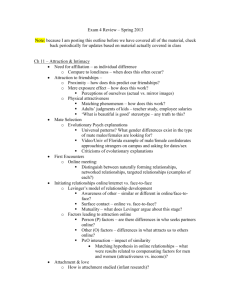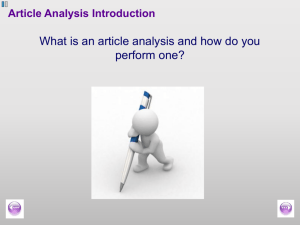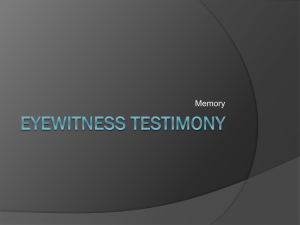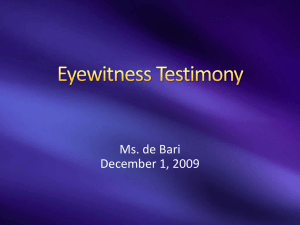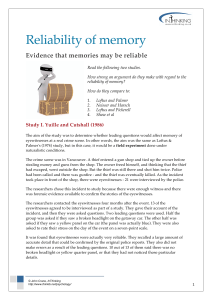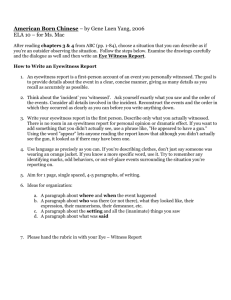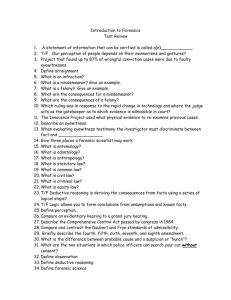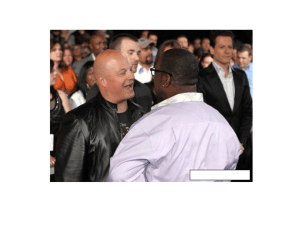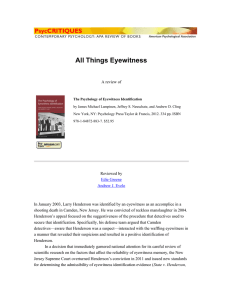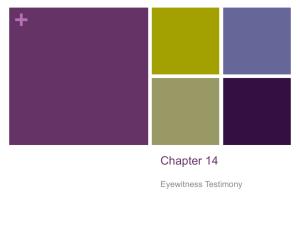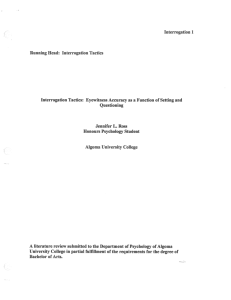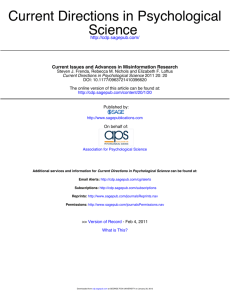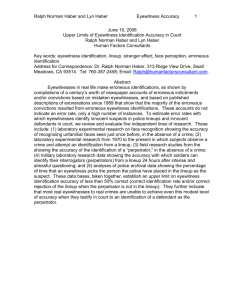Exam 4 Review – Spring 2015 - Illinois State University Websites
advertisement
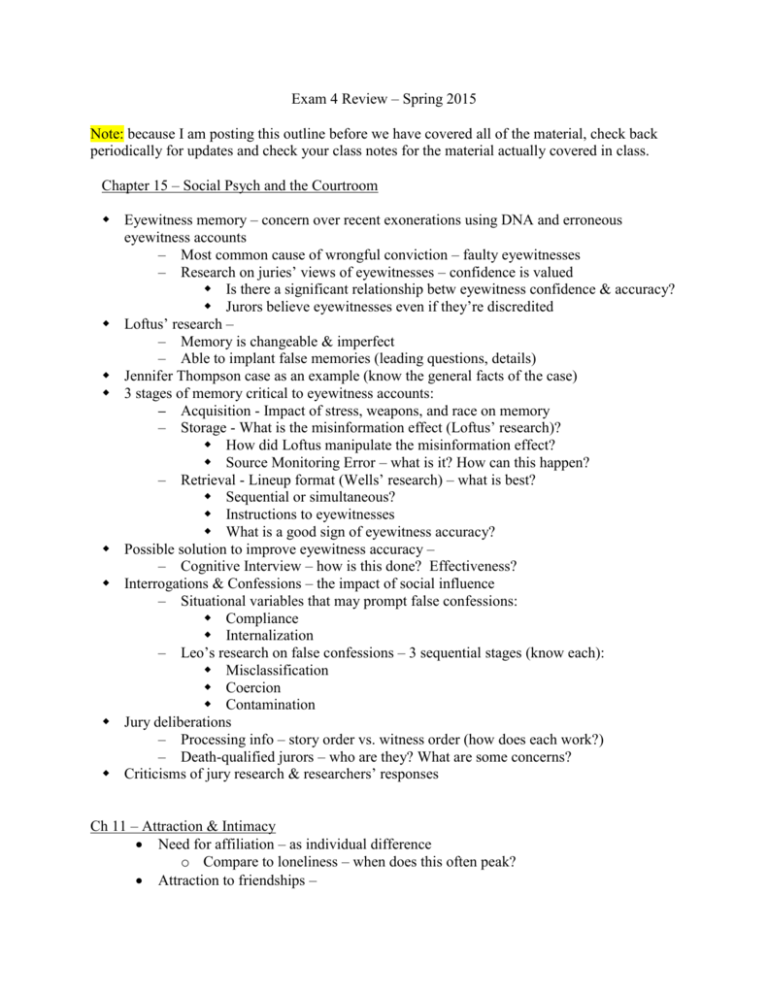
Exam 4 Review – Spring 2015 Note: because I am posting this outline before we have covered all of the material, check back periodically for updates and check your class notes for the material actually covered in class. Chapter 15 – Social Psych and the Courtroom Eyewitness memory – concern over recent exonerations using DNA and erroneous eyewitness accounts – Most common cause of wrongful conviction – faulty eyewitnesses – Research on juries’ views of eyewitnesses – confidence is valued Is there a significant relationship betw eyewitness confidence & accuracy? Jurors believe eyewitnesses even if they’re discredited Loftus’ research – – Memory is changeable & imperfect – Able to implant false memories (leading questions, details) Jennifer Thompson case as an example (know the general facts of the case) 3 stages of memory critical to eyewitness accounts: – Acquisition - Impact of stress, weapons, and race on memory – Storage - What is the misinformation effect (Loftus’ research)? How did Loftus manipulate the misinformation effect? Source Monitoring Error – what is it? How can this happen? – Retrieval - Lineup format (Wells’ research) – what is best? Sequential or simultaneous? Instructions to eyewitnesses What is a good sign of eyewitness accuracy? Possible solution to improve eyewitness accuracy – – Cognitive Interview – how is this done? Effectiveness? Interrogations & Confessions – the impact of social influence – Situational variables that may prompt false confessions: Compliance Internalization – Leo’s research on false confessions – 3 sequential stages (know each): Misclassification Coercion Contamination Jury deliberations – Processing info – story order vs. witness order (how does each work?) – Death-qualified jurors – who are they? What are some concerns? Criticisms of jury research & researchers’ responses Ch 11 – Attraction & Intimacy Need for affiliation – as individual difference o Compare to loneliness – when does this often peak? Attraction to friendships – o Proximity – how does this predict our friendships? o Mere exposure effect – how does this work? Perceptions of ourselves (actual vs. mirror images) o Physical attractiveness Matching phenomenon – how does this work? Adults’ judgments of kids – teacher study, employee salaries ‘What is beautiful is good’ stereotype – any truth to this (correlations with other dimensions)? Mate Selection o Evolutionary Psych explanations argue that gender differences exist in the type of mate men and women are looking for based on… what? Beauty standards vary based on cultures but we generally prefer…? Gender differences in motivations for relationships Universal patterns of concern for offspring Female perspective according to evolutionary psych – more selective than men Male perspective according to evolutionary psych – less selective & search for young, healthy mates Video/Florida State Univ study - male/female confederates approaching strangers on campus and asking for dates/sex. What were results? Criticisms of evolutionary explanations – what are they? First Encounters o Online meeting: Distinguish between naturally forming relationships, networked relationships, targeted relationships (examples of each?) Initiating relationships online/internet vs. face-to-face o Levinger’s model of relationship development Awareness of other – similar or different in online/face-to-face? Surface contact – online vs. face-to-face? Mutuality – what does Levinger argue about this stage? o Factors leading to attraction online Person (P) factors –differences among those who seek partners online? Other (O) factors – differences in what attracts us to others online? PxO interaction – impact of similarity Matching hypothesis in online relationships – what were results related to compensating factors for men and women (attractiveness vs. income)? o Effectiveness of online dating services? What do their algorithms focus on? What are best predictors of success in long-term relationships? Attachment & love o How is attachment studied (infant research)? o What are the 3 attachment styles? Behavior examples of each? o Is attachment stable over time? o Newer research dividing the ‘avoidant’ group into fearfully-avoidant and dismissive-avoidant Theories of love o Passionate/Companionate love – definitions of each Changes over time in passionate & companionate love? Men are from Mars, Women are from Venus video – main points? Conflict between couples? Gender differences? Patterns of Marriage – when does satisfaction typically decrease? o Communication patterns – Negative affect reciprocity; Demand-withdraw pattern; Relationship-enhancing attributions. Examples? Detaching from Relationships – Coping responses (loyalty, voice, neglect, exit). Positive : Negative interactions in successful marriages Ch 12 – Helping Others Motives for altruism Evolutionary explanations Kin Selection – what evidence supports this? Reciprocity Empathy – cognitive and emotional components? Toddler & animal research? Cost-reward model Social exchange: possible rewards from helping? When is helping egoistic vs. altruistic? Bystander Effect (Latane & Darley’s research) Kitty Genovese example that started research on bystanders Latane & Darley’s follow-up experiments (confederate having a seizure, smokefilled room) to examine the bystander effect – what is found? What is diffusion of responsibility? What is pluralistic ignorance? Shotland experiment on intervening in male/female violence: Impact of assumptions about their relationship Other Situational Influences (rural, culture, role models, attractiveness) – how do these influence helping? Ways to increase helping Awareness of the bystander effect Avoid overjustification – how?
